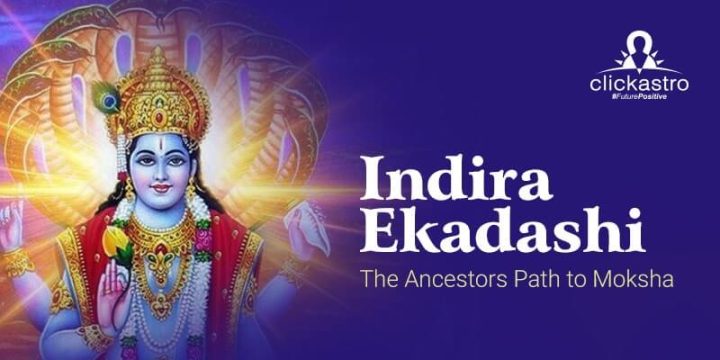Contents[hide]
When is Indira Ekadashi in 2023?
In 2023, Indira Ekadashi will be observed on Tuesday, 10 October 2023.
Auspicious timings for Indira Ekadashi 2023
- Sunrise – October 10, 2023 6:25 AM
- Sunset – October 10, 2023 6:02 PM
- Ekadashi Tithi Starts – October 09, 2023 12:37 PM
- Ekadashi Tithi Concludes – October 10, 2023 3:09 PM
- Dwadashi End Timing – October 11, 2023 5:37 PM
- Hari Vasara End Timing – October 10, 2023 9:46 PM
- Parana Time – October 11, 6:25 AM – October 11, 8:45 AM
Indira Ekadashi Rituals
Devotees observe the Indira Ekadashi Vrat from the eve of Indira Ekadashi, i.e., from Dashami. The fast lasts 24 hours, beginning with the sunrise of Ekadashi and ending with the sunset of Dwadashi. While most devotees observe a strict fast during this time, some observe a partial fast by consuming one meal before sunrise. The fast is concluded after offering prayers to Lord Vishnu and offering food to the Brahmins. Some followers may consume only dairy products and fruits during the fast.
Starting from Dashami, devotees recite mantras and sing hymns praising the greatness and grace of Lord Vishnu. Reciting the Vishnu Sahasranama is also considered to be highly auspicious during Ekadashi day.
On Ekadashi day, devotees must ideally brush their teeth with traditional Datun, but if that is not available, the mouth should be cleaned with lemon, Jamun berries, or mango leaves. It should be noted that plucking leaves from trees is forbidden on Ekadashi day and therefore the leaves that have fallen from trees should be used to clean the mouth.
It is considered highly auspicious to bathe in holy rivers and ponds on this day; however, if such places are not accessible, then the devotees can bathe at home.
Devotees must recite the Bhagawad Geeta on Ekadashi day. They must also observe a Jagran on the night of Ekadashi.
While offering bhog to the Lord devotees must ensure to place a Tulsi leaf on the food.
Observers may consume only fruits and nuts during the Indira Ekadashi fast. They may also consume seasonal fruits like banana, mango, almond, pistachio, etc.
On Dwadashi day, the devotees must ensure to offer food, sweets, and Dakshina to the Brahmins before concluding the fast.
While most devotees observe a strict fast during this time, some observe a partial fast by consuming one meal before sunrise. The fast is concluded after offering prayers to Lord Vishnu and offering food to the Brahmins. Some followers may consume only dairy products and fruits during the fast.
Starting from Dashami, devotees recite mantras and sing hymns praising the greatness and grace of Lord Vishnu. Reciting the Vishnu Sahasranama is also considered to be highly auspicious during Ekadashi day.
On Ekadashi day, devotees must ideally brush their teeth with traditional Datun, but if that is not available, the mouth should be cleaned with lemon, Jamun berries, or mango leaves. It should be noted that plucking leaves from trees is forbidden on Ekadashi day and therefore the leaves that have fallen from trees should be used to clean the mouth.
It is considered highly auspicious to bathe in holy rivers and ponds on this day; however, if such places are not accessible, then the devotees can bathe at home.
Devotees must recite the Bhagawad Geeta on Ekadashi day. They must also observe a Jagran on the night of Ekadashi.
While offering bhog to the Lord devotees must ensure to place a Tulsi leaf on the food.
Observers may consume only fruits and nuts during the Indira Ekadashi fast. They may also consume seasonal fruits like banana, mango, almond, pistachio, etc.
On Dwadashi day, the devotees must ensure to offer food, sweets, and Dakshina to the Brahmins before concluding the fast.
Puja Vidhi and Vrat Vidhi for Indira Ekadashi
- On Ekadashi day, devotees must rise early before sunrise, have their bath, and put on clean clothes. After bath they must meditate on the Shaligram form of Lord Vishnu and take a vow to observe a strict and complete Indira Ekadashi fast.
- Draw a swastika form with Kumkum on the cloth and offer rice and flowers. While doing so, the observer must chant “Om Ganeshaya Namah” and offer reverence to Lord Ganesha.
- Install the Shaligram or a picture or idol of Lord Vishnu in puja area and perform puja to Lord Vishnu by offering Gangajal abhisheka on the idol or picture of Lord Vishnu. Offerings of kumkum, sandalwood, incense, sweets, Akshat, etc. are then offered to the Lord.
- The devotee must then read the Vishnu Sahasranama and perform aarti.
- They must offer Shraddha for their deceased ancestors and donate food to the Brahmins after performing the Shraddha
- In the evening, after lighting a lamp in front of the Tulsi plant, the devotees must either read or listen to the story of Indira Ekadashi Vrat.
- The devotees must observe a Jagran and spend the night singing hymns and chanting mantras praising the grace of Lord Vishnu.
- On Dwadashi day, after having bath and offering prayers and aarti to Lord Vishnu, the devotees must conclude their fast by consuming fruits.
What to avoid during Indira Ekadashi
- Devotees must avoid all Tamasik food on Ekadashi.
- Avoid indulgences of all kinds on Ekadashi day.
- The observer must observe celibacy during Ekadashi fast.
- Sweeping the house on Ekadashi day is prohibited.
- One must avoid shaving and hair cutting activities on Ekadashi.
- The observer must avoid speaking and maintain silence during Ekadashi vrat.
- Maintaining minimal speech and being respectful and polite is essential while observing the Ekadashi fast. The observer must be truthful, polite, honest and maintain peace and calm while observing the fast.
Indira Ekadashi Vrat Katha
The Mahabharata cites the story behind Indira Ekadashi. According to the Mahabharata, once Yudhishthira asked Lord Krishna about the Krishna Paksha Ekadashi during Ashwin month and what was it named. He further sought the explanation regarding the benefits of fasting on this day and the story behind Indira Ekadashi. Hence Lord Krishna explains the story and significance of Indira Ekadashi to Yudhishthira which is as follows: According to the legend, during the Satyuga period, there lived a majestic king named Indrasen who ruled the ancient city of Mahishmati. He was a deeply religious man and an ardent devotee of Lord Vishnu. He took diligent care of his subjects and everyone in his kingdom lived happily without facing any troubles. The kingdom was blessed with happiness and wealth under his reign. One day as King Indrasen presided over his assembly, Sage Narada appeared in his court. The king offered him a place in the assembly and treated him with great regard. He then enquired about the reason for Sage Narada’s visit. Sage Narada informed the king that while his kingdom enjoyed happiness, Indrasen’s father was suffering in Yamalok because of his bad deeds during his previous life. King Indrasen’s father requested Sage Narada to pass the message to his son. He wanted king Indrasen to observe the Indira Ekadashi fast strictly as per the ritual during the Krishna Paksha phase of Ashwini month in order to free him from Yamalok and seek a place in heaven. Hearing this, King Indrasen sought the advice of Sage Narada about the Indira Ekadashi fast and the method and rituals to be followed during Indira Ekadashi which would help to atone his father’s sins. Sage Narada explained the rituals to King Indrasen. He advised that he must observe the Indira Ekadashi fast with full dedication from Dashami Tithi and avoid all sorts of indulgences and Tamasik food and worship Lord Vishnu with absolute devotion. On Ekadashi day, after taking a dip in the holy waters, the observer must worship the ancestors with devotion and observe all rituals of the fast dedicatedly. After learning about the fasting methodology from Sage Narada, King Indrasen observed the Indira Ekadashi fast ardently along with his family members. Due to the positive outcome of his fast, King Indrasen’s father obtained a place in heaven. King Indrasen, too, gained the positive outcome from his fast as he reigned over his kingdom peacefully and eventually gained a place in heaven for himself.Significance of Indira Ekadashi Vrat
The significance of Indira Ekadashi is mentioned in the ‘Brahmavaivarta Purana’ during a conversation between Yudhishthira and Lord Krishna during which Lord Krishna explained the significance of the Indira Ekadashi fast. The Indira Ekadashi fast is meant to cleanse one’s soul of all sins. It is also associated with salvation of the ancestors and obtaining peace for their souls. Lord Vishnu liberates all those observing the fast with complete devotion. The fast purges all sins and bestows Raja Sukha or absolute pleasure and good fortune in their lives. Furthermore, reading Vishnu Sahasranama, along with fasting rituals and worshipping the Lord, is extremely important which helps in bringing about peace in all three worlds. The Hindu scriptures further describe that by observing the Indira Ekadashi fast, one yields the same benefits equivalent to performing the ‘Ashvamedha Yagya.’ This emphasises the significance of this Ekadashi fast over others.Indira Ekadashi festival dates between 2023 & 2027
| Year | Day | Date |
| 2023 | Tuesday | 10-Oct-23 |
| 2024 | Saturday | 28-Sep-24 |
| 2025 | Wednesday | 17-Sep-25 |
| 2026 | Tuesday | 6-Oct-26 |
| 2027 | Sunday | 26-Sep-27 |







